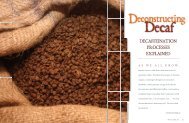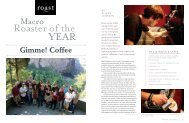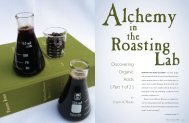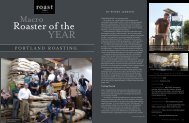to download a low resolution preview of this article - Roast Magazine
to download a low resolution preview of this article - Roast Magazine
to download a low resolution preview of this article - Roast Magazine
You also want an ePaper? Increase the reach of your titles
YUMPU automatically turns print PDFs into web optimized ePapers that Google loves.
Crafting<br />
Collaboration<br />
Learning<br />
From<br />
And<br />
Growing<br />
With<br />
Craft<br />
Beer<br />
by Alexandra Ka<strong>to</strong>na-Carroll<br />
and Chris<strong>to</strong>pher Schooley<br />
Comparing two handcrafted products can be<br />
pretty tricky. As artisans, we mostly want<br />
<strong>to</strong> promote the uniqueness <strong>of</strong> the product<br />
with which we’re pr<strong>of</strong>essionally involved and invested,<br />
rather than tie it imperfectly <strong>to</strong> what on the surface is a<br />
very different product. Over the years, specialty c<strong>of</strong>fee<br />
has been compared <strong>to</strong> fresh produce and wine. But the<br />
product that may be the most sympathetic and helpful<br />
<strong>to</strong> specialty c<strong>of</strong>fee is craft beer.<br />
One <strong>of</strong> the biggest hurdles for <strong>this</strong> comparison is<br />
that craft beer is a product that can be easily enjoyed<br />
without many complications (consequences aside).<br />
C<strong>of</strong>fee, on the other hand, is not always sold as a<br />
finalized product and has numerous opportunities for<br />
error, as we know all <strong>to</strong>o well. However, the similarities<br />
between these two industries are vast, and there are<br />
several areas <strong>of</strong> the beer industry from which specialty<br />
c<strong>of</strong>fee can learn and thereby flourish.<br />
continued on page 40<br />
38 roast July | August 2012 39
Crafting Collaboration | Learning From and Growing With Craft Beer (continued)<br />
Craft Beer His<strong>to</strong>ry<br />
First, let’s start with some his<strong>to</strong>ry <strong>of</strong> the craft beer movement.<br />
The American Homebrewers Association formed in 1978, dedicated<br />
<strong>to</strong> promoting and protecting amateur and pr<strong>of</strong>essional craft<br />
brewers. In 1982, the Great American Beer Festival (GABF) debuted,<br />
and the formation <strong>of</strong> the Association <strong>of</strong> Brewers fol<strong>low</strong>ed a year<br />
later (eventually in 2005 they joined forces <strong>to</strong> create the Brewers<br />
Association). It’s safe <strong>to</strong> say that the development <strong>of</strong> the Specialty<br />
C<strong>of</strong>fee Association <strong>of</strong> America (SCAA), which formed in 1982, and the<br />
Barrels <strong>of</strong> beer | pho<strong>to</strong> by Alexandra Ka<strong>to</strong>na-Carroll<br />
Brewers Association have had unique paths: SCAA is made up purely<br />
<strong>of</strong> companies within and aligned with the specialty c<strong>of</strong>fee industry,<br />
while the Brewers Association has focused on all levels <strong>of</strong> craft beer,<br />
from home brewers <strong>to</strong> craft breweries, retailers and consumers.<br />
The Brewers Association defines an American craft brewer as<br />
“small, independent and traditional” (for the full breakdown, visit<br />
www.brewersassociation.org). The first GABF had just 850 people in<br />
attendance and featured brews from Sierra Nevada, Anchor Steam and<br />
Coors (yes, Coors). Flash forward 30 years and in 2011, the GABF sold<br />
out in a week, had almost 50,000 people in attendance and featured<br />
2,375 craft beers.<br />
Over the past several years, craft beer has experienced explosive<br />
growth. In 2010, the craft brewing industry grew 11 percent in volume<br />
and 12 percent by dollars compared <strong>to</strong> the growth in 2009. Craft brewer<br />
dollar sales rose by 15 percent in 2011, while sales <strong>of</strong> large, massproduced<br />
beers like Coors and Budweiser (or, as the craft beer industry<br />
calls them, “fizzy yel<strong>low</strong> beer”) dipped. In addition, nearly 1,000 craft<br />
breweries are in development for 2012. But before you drop your triers<br />
and run out the door <strong>to</strong> start your own brewery, it’s important <strong>to</strong> note<br />
that, like specialty c<strong>of</strong>fee, craft beer only comprises about 5 percent<br />
<strong>of</strong> the <strong>to</strong>tal market. It’s certainly growing, as the numbers indicate,<br />
and one day Charlie Papazian, head <strong>of</strong> the Brewers Association, hopes<br />
<strong>to</strong> see craft beer owning more along the lines <strong>of</strong> 15 <strong>to</strong> 20 percent <strong>of</strong> the<br />
market.<br />
continued on page 42<br />
Cupping and tasting in the Odell Brewing Tap Room in Fort Collins, Colo. | pho<strong>to</strong> by Chris<strong>to</strong>pher Schooley<br />
40 roast July | August 2012 41
Crafting Collaboration | Learning From Craft Beer (continued)<br />
Those are certainly l<strong>of</strong>ty goals, but the Brewers Association encompasses a number <strong>of</strong><br />
activities that could help the industry get there. “The Brewers Association <strong>of</strong>fers many different<br />
avenues for communication, cooperation and learning,” says Doug Odell, a co-founder <strong>of</strong><br />
Odell Brewing Company in Fort Collins, Colo. “They also help connect small brewers with our<br />
cus<strong>to</strong>mers and potential cus<strong>to</strong>mers through public events.”<br />
The GABF and Savor, another festival put on by the Brewers Association, are just two<br />
consumer-focused festivals among hundreds throughout the year. The craft beer industry has<br />
done an incredible job <strong>of</strong> creating community within the industry and engaging consumers<br />
through different types <strong>of</strong> events, including beer dinners, festivals and American Craft Beer<br />
Week. Additionally, the industry has a plethora <strong>of</strong> accessible media, including online forums,<br />
blogs, magazines and review sites, such as Beer Advocate, which has 1.5 million unique<br />
monthly visi<strong>to</strong>rs. In return, they have a devout, passionate fol<strong>low</strong>ing that continues <strong>to</strong> learn<br />
and grow simultaneously. As the industry continues <strong>to</strong> gain momentum, more sites have<br />
become available that make finding and learning about craft beer even more accessible and<br />
approachable.<br />
Conversely, much <strong>of</strong> the <strong>to</strong>ne <strong>of</strong> the interactions between specialty c<strong>of</strong>fee pr<strong>of</strong>essionals<br />
and consumers is geared <strong>to</strong>ward trying <strong>to</strong> convince the consumers what they should be tasting<br />
instead <strong>of</strong> asking them what they’re tasting and what they do or don’t like about it. The<br />
language <strong>to</strong> describe great c<strong>of</strong>fee has <strong>to</strong> become more widely used and useful <strong>to</strong> consumers,<br />
and avenues for consumer feedback need <strong>to</strong> be made not just more accessible, but actually be<br />
created in the first place.<br />
Collaborating for<br />
Long-Term Success<br />
According <strong>to</strong> Papazian, collaboration among brewers has also played a key role in craft beer’s<br />
success. “Craft brewers are all on the same page,” he says. “They’re willing <strong>to</strong> collaborate for<br />
common goals.”<br />
Many craft breweries get <strong>to</strong>gether <strong>to</strong> release a collaboration brew, which combines<br />
several ingredients and ideas from two or more breweries for one common product. And some<br />
collaborations between specialty c<strong>of</strong>fee and craft beer have also been great successes for both<br />
participants. Several specialty c<strong>of</strong>fee companies—including Brooklyn’s Gorilla C<strong>of</strong>fee, Austin’s<br />
Cuvee C<strong>of</strong>fee and Chicago-based Intelligentsia—have been successfully collaborating with local<br />
brewers.<br />
Let’s not sell the specialty c<strong>of</strong>fee industry short. With SCAA events like the <strong>Roast</strong>ers Guild<br />
Retreat, Camp Pull-A-Shot, Symposium and the annual Expo, the industry comes <strong>to</strong>gether<br />
several times a year <strong>to</strong> share information and collaborate for long-term success. There’s also<br />
a handful <strong>of</strong> regional roaster groups around the country, regional barista competitions and<br />
Comparing c<strong>of</strong>fees and beers in the Odell Brewing Tap Room in Fort Collins, Colo. | pho<strong>to</strong> by Chris<strong>to</strong>pher Schooley<br />
Cupping and tasting in the Odell Brewing Tap Room in Fort Collins, Colo. | pho<strong>to</strong> by Chris<strong>to</strong>pher Schooley<br />
barista jams that increase community and al<strong>low</strong> participants <strong>to</strong> focus on and talk about<br />
quality, characteristics and uniqueness <strong>of</strong> the product. C<strong>of</strong>fee Common has been extremely<br />
successful at showcasing the <strong>to</strong>p baristas in the world at influential non-c<strong>of</strong>fee-themed<br />
events. And with events like Cup <strong>of</strong> Excellence and <strong>Roast</strong>ers Guild C<strong>of</strong>fees <strong>of</strong> the Year,<br />
producers and farms are being recognized for their craft and dedication <strong>to</strong> quality.<br />
discovering similarities<br />
The challenges that the craft beer and specialty c<strong>of</strong>fee industries currently face are strikingly<br />
similar: preserving authenticity, driving innovation, and maintaining freshness and quality.<br />
Both use price <strong>to</strong> differentiate themselves in a competitive market and provide more in-depth<br />
information about the product. One <strong>of</strong> the most important pieces <strong>of</strong> information either<br />
industry can put on its packaging relate <strong>to</strong> a freshness date. Several craft breweries, including<br />
well-known companies like Dogfish Head and Allagash, are even eliminating sales in certain<br />
states <strong>to</strong> focus on smaller distribution and more local markets (and, ultimately, <strong>to</strong> gain better<br />
quality control).<br />
And while freshness and having indica<strong>to</strong>rs <strong>of</strong> freshness are key, using other information<br />
<strong>to</strong> tell the s<strong>to</strong>ry <strong>of</strong> the product also plays a role in setting craft beer apart. Printing the alcohol<br />
by volume percentage (ABV%), hop varietals, and origins <strong>of</strong> grains and other ingredients<br />
serves a similar purpose <strong>to</strong> varietal and farm information on specialty c<strong>of</strong>fee packaging.<br />
Talking about process and ingredients is integral <strong>to</strong> designating a product as craft and<br />
specialty. And while maintaining authenticity and passion through the s<strong>to</strong>ry behind the<br />
product is critical, it’s a delicate balance <strong>to</strong> reach without sounding <strong>to</strong>o gimmicky.<br />
There’s an impetus for the two industries meeting and collaborating with each other,<br />
which truly shows great promise. The conversations between the two industries can be<br />
at quite an elevated level since people who work in both industries already have such a<br />
deep understanding about the importance <strong>of</strong> quality ingredients and materials as well as<br />
craftsmanship and skill. There are also many similarities in our processes.<br />
continued on page 44<br />
42 roast July | August 2012 43
Crafting Collaboration | Learning From and Growing With Craft Beer (continued)<br />
Both beer and c<strong>of</strong>fee are tied <strong>to</strong> agriculture and the impact <strong>of</strong> the<br />
<strong>of</strong> specialty c<strong>of</strong>fee, and vice versa, it would be<br />
commodities market on supply. Craft beer has an opportunity <strong>to</strong> elevate<br />
equally beneficial for both industries. In these<br />
and celebrate the grain and hops producer in a way that specialty c<strong>of</strong>fee<br />
segments, we potentially have and can be the<br />
has done for c<strong>of</strong>fee producers. Also, c<strong>of</strong>fee processing parallels in many<br />
perfect cus<strong>to</strong>mer.<br />
ways with the cleaning, grading and malting <strong>of</strong> grains for brewing—if<br />
not literally, than at least on a level <strong>of</strong> value that’s added <strong>to</strong> the<br />
agricultural product through these procedures.<br />
One <strong>of</strong> the biggest parallels between the two industries is in roasting.<br />
Most beer styles have a base produced from the kilning <strong>of</strong> pale malts, but<br />
in certain styles <strong>of</strong> beer, grains are roasted <strong>to</strong> become “specialty malts”<br />
common<br />
challenges<br />
Hops before harvest.<br />
in order <strong>to</strong> add certain flavors and characteristics <strong>to</strong> them. Beer styles,<br />
such as porters, amber ales, brown ales and s<strong>to</strong>uts, are determined by<br />
the roast level <strong>of</strong> the grains. The malt roasters used can be very similar<br />
<strong>to</strong> c<strong>of</strong>fee roasters, and you would certainly recognize the names <strong>of</strong> the<br />
manufacturers <strong>of</strong> these roasters, such as Probat or Barth. It would be a lot<br />
<strong>of</strong> fun and very educational <strong>to</strong> compare grain and c<strong>of</strong>fee roasting.<br />
The idea that we have so much in common with craft beer is not<br />
only inspiring in the context <strong>of</strong> starting dialogue about our processes,<br />
but also in looking at the craft beer industry as a consumer category in<br />
and <strong>of</strong> itself. Both products have very little <strong>of</strong> the market share in their<br />
respective categories, but since both are specialty and craft, we are by<br />
definition not ever going <strong>to</strong> own a large chunk <strong>of</strong> the greater market.<br />
There is still a lot <strong>of</strong> room for growth, though, particularly in specific<br />
segments. If we can focus on getting a large percentage <strong>of</strong> the people<br />
who work in craft beer <strong>to</strong> be able <strong>to</strong> identify and be regular consumers<br />
So how does the specialty c<strong>of</strong>fee industry<br />
continue <strong>to</strong> increase culture around our beloved<br />
product? We’ve seen a shift from retail- <strong>to</strong><br />
home-brewed c<strong>of</strong>fee, and it’s essential that<br />
the process is accessible. After all, brewing<br />
c<strong>of</strong>fee in one’s home, for many, is a ritual that<br />
carries contentment, sacredness and nostalgia.<br />
Increasing access <strong>to</strong> home roasting could be<br />
another way <strong>to</strong> build culture and momentum,<br />
as it sparked the craft beer movement years<br />
ago (via home brewing). There is tremendous<br />
value in putting the craft process directly<br />
in the consumer’s hands, giving them the<br />
continued on page 46<br />
Home brewing and home roasting equipment at Hops and Berries in Fort Collins, Colo. |<br />
pho<strong>to</strong> by Chris<strong>to</strong>pher Schooley<br />
44 roast July | August 2012 45
Crafting Collaboration | Learning From and Growing With Craft Beer (continued)<br />
opportunity <strong>to</strong> watch the c<strong>of</strong>fee turn brown right<br />
in front <strong>of</strong> their eyes.<br />
Jones C<strong>of</strong>fee <strong>Roast</strong>ers in Pasadena, Calif.,<br />
invites cus<strong>to</strong>mers <strong>to</strong> bring in their home brewing<br />
equipment for a hands-on workshop. The<br />
company makes learning about home brewing<br />
incredibly approachable; with guided instruction<br />
and calibration, it al<strong>low</strong>s cus<strong>to</strong>mers <strong>to</strong> use their<br />
existing equipment much more effectively<br />
and confidently. Ultimately, <strong>this</strong> can increase<br />
wholesale revenue and have a high return on<br />
investment. However, many <strong>of</strong> us are facing a<br />
similar competi<strong>to</strong>r, and it’s not the other specialty<br />
c<strong>of</strong>fee retailer down the street.<br />
We’re facing growing competition from the<br />
single-service pod, “press a but<strong>to</strong>n and it’s done<br />
even though the taste leaves much <strong>to</strong> be desired at<br />
such a high price point” c<strong>of</strong>fees. As the co-founder<br />
and direc<strong>to</strong>r <strong>of</strong> Square Mile C<strong>of</strong>fee <strong>Roast</strong>ers,<br />
James H<strong>of</strong>fmann, stated on his blog in February<br />
2012: “I don’t think we should be beating the<br />
drum <strong>of</strong> anger about Nespresso and K-Cups retail<br />
prices, unless we never aspire <strong>to</strong> them ourselves.<br />
We should be learning the lessons they provide<br />
us—how <strong>to</strong> sell c<strong>of</strong>fee effectively, how <strong>to</strong> make<br />
c<strong>of</strong>fee at a higher price point more accessible—and<br />
answer some less comfortable questions such as<br />
Hops varietals at Hops and Berries in Fort Collins, Colo. | pho<strong>to</strong> by Chris<strong>to</strong>pher Schooley<br />
Malts at Hops and Berries in Fort Collins, Colo. | pho<strong>to</strong> by Chris<strong>to</strong>pher Schooley<br />
why we’re considered overpriced, and why we might be inaccessible<br />
in comparison.”<br />
In an effort <strong>to</strong> become even more accessible, craft beer started<br />
its own canned beer revolution recently and had <strong>to</strong> battle many<br />
preconceived perceptions about canned beer. “When we started, the<br />
idea <strong>of</strong> canning beer was blasphemous,” says Dale Katechis, founder<br />
<strong>of</strong> Colorado-based Oskar Blues. “It was frowned upon as a cheap<br />
way <strong>to</strong> deliver lager-style cheap beer. The fact is, if you put bad beer<br />
in a can, it’s going <strong>to</strong> be bad beer. But our goal is <strong>to</strong> deliver beer as<br />
fresh as possible, and the can is the best.” Cans preserve freshness<br />
and are easier on the environment, and consumers have embraced<br />
the trend. Now, nearly 200 craft breweries have started <strong>to</strong> can their<br />
products, making them more portable and open <strong>to</strong> certain venues,<br />
like stadiums and tailgating.<br />
Creating a more accessible route for our products <strong>to</strong> be enjoyed is<br />
essential <strong>to</strong> staying competitive, and they should always be preserved<br />
for freshness in the most effective way. Certain companies have<br />
supported <strong>this</strong> approach by selling cold-brew c<strong>of</strong>fee in bottles, and<br />
many are starting <strong>to</strong> come up with other portable options for their<br />
products, which is certainly a step in the right direction.<br />
Moving forward, the specialty c<strong>of</strong>fee industry could focus<br />
on <strong>of</strong>fering increased opportunities for consumers <strong>to</strong> both learn<br />
and share their opinion about products. Flavor notes are usually<br />
provided, but that’s usually a one-way conversation without input<br />
continued on page 48<br />
46 roast July | August 2012 47
Crafting Collaboration | Learning From and Growing With Craft Beer (continued)<br />
from the consumer. Offering a more<br />
approachable path for consumers <strong>to</strong><br />
engage and understand our products, and<br />
provide feedback, is integral <strong>to</strong> developing<br />
a collective <strong>of</strong> devout specialty c<strong>of</strong>fee<br />
enthusiasts. More consumer-driven events<br />
will certainly help spark interest and engage<br />
larger crowds about what’s behind the<br />
product, why it’s so special and what makes<br />
it unique.<br />
And what about shared events? There<br />
is much ground <strong>to</strong> be gained by addressing<br />
consumers as a unified front <strong>of</strong> craft goods<br />
purveyors: making connections not just<br />
for ourselves and our own understanding<br />
<strong>of</strong> other craft products, but encouraging<br />
consumers <strong>to</strong> make those connections.<br />
Being enthusiastic consumers <strong>of</strong> one craft<br />
product has a great chance <strong>of</strong> leading fans<br />
Three Floyds’ Dark Lord s<strong>to</strong>ut and Intelligentsia c<strong>of</strong>fee | pho<strong>to</strong> by David Leep<br />
<strong>to</strong> be enthusiastic consumers <strong>of</strong> another.<br />
For the annual <strong>Roast</strong>ers Guild Retreat, the<br />
<strong>Roast</strong>ers Guild Executive Council has always<br />
tried <strong>to</strong> partner with or showcase a local brewery with its kegs<br />
available at the social functions at the event. What if there was a<br />
<strong>Roast</strong>ers Guild or SCAA booth at the GABF that showcased a number<br />
<strong>of</strong> different beer/c<strong>of</strong>fee collaborations?<br />
Both specialty c<strong>of</strong>fee and craft beer are competing against<br />
marketing from multinational firms that use terminology from<br />
craft segments <strong>to</strong> try <strong>to</strong> reach the craft drinker. Their use <strong>of</strong> words<br />
like artisanal or packaging that mimics a specialty product by<br />
adding some general information about the beer or c<strong>of</strong>fee directly<br />
challenges our efforts. Truly setting ourselves apart by delivering<br />
quality and teaching consumers how <strong>to</strong> identify it is our best<br />
defense. In many ways, craft beer and specialty c<strong>of</strong>fee are the<br />
quintessential independent businesses in many communities<br />
throughout the United States and beyond. Combining our efforts<br />
<strong>to</strong> enrich these communities will prove <strong>to</strong> be a great benefit for<br />
New Belgium Brewing: different product levels | pho<strong>to</strong> by Chris<strong>to</strong>pher Schooley<br />
everyone.<br />
Alexandra Ka<strong>to</strong>na-Carroll is the founder <strong>of</strong> Sensaay, a<br />
new company dedicated <strong>to</strong> the promotion <strong>of</strong> craft beer, specialty c<strong>of</strong>fee and fine tea.<br />
She has been in the specialty c<strong>of</strong>fee industry for nearly six years and is a member <strong>of</strong><br />
SCAA’s Sustainability Council. Contact her via e-mail at alex@sensaay.com.<br />
Chris<strong>to</strong>pher Schooley is a c<strong>of</strong>fee roaster who works for Sweet<br />
Maria’s and C<strong>of</strong>fee Shrub and is the Immediate Past Chair <strong>of</strong> the <strong>Roast</strong>ers Guild<br />
Executive Council. He lives in Fort Collins, Colo., which is home <strong>to</strong> a number <strong>of</strong> the<br />
finest craft breweries in the country, a number <strong>of</strong> specialty c<strong>of</strong>fee roasters, and an<br />
expanding and dynamic craft community. Contact him via e-mail at<br />
chris@c<strong>of</strong>feeshrub.com.<br />
Information on the New Belgium bottles | pho<strong>to</strong> by Chris<strong>to</strong>pher Schooley<br />
48 roast July | August 2012 49
















